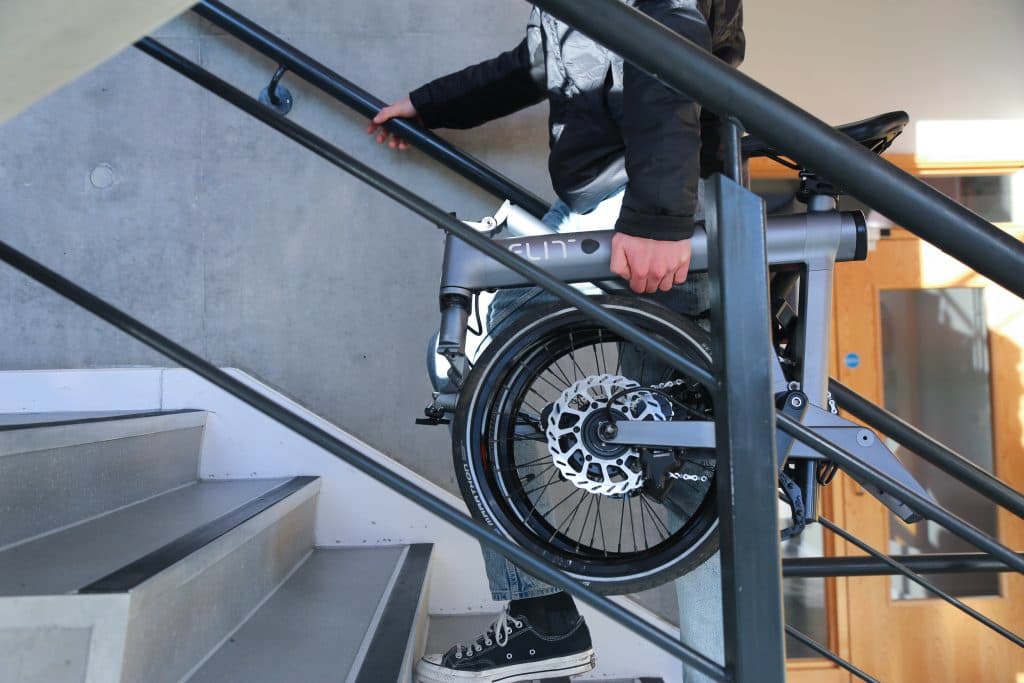At the Micromobility Europe conference in Amsterdam last week, I got my first look at (and first ride on) the new folding electric bike known as FLIT. As it turns out, there’s a new ultra-compact British folding e-bike in town.
When it comes to UK-based folding bikes, most people already know of Brompton. The super-tiny folding bike riding on little 16-inch wheels has been the darling of the compact folding bike space for decades.
Brompton’s folding bikes are iconic, combining classic bicycle design with modern engineering principles to create the perfect tiny folder. It’s a bike that packs up compactly and then opens back up to ride pretty darn well, at least for a 16-inch narrow-tire bike.
But when Brompton joined the modern era and electrified their bikes, the same design decisions that made the original bike so effective were also a hindrance to advanced e-bike components. That resulted in a bike that looked like it was wearing an eBay conversion kit with a battery in a shopping bag, not to mention a front wheel motor that limited power and traction.
Enter FLIT: another British folding bike, but this time designed from the outset for electric drive.

Because the company started with electrification in mind, they designed the bike with a wide enough central frame tube to support the 36V 6.4Ah battery hidden away inside the tube. A custom-designed battery shell allows the battery to be easily removed for charging by first sliding out the seat tube.
Next, the use of a rear motor instead of a front motor also allows for much more peppy acceleration. The 250W motor may only be rated for 35 Nm of torque, but in my test ride of the bike, I was impressed with just how potent that power felt. Surely the inclusion of a torque sensor helped, but the rear wheel drive is key to being able to dump all of the available power as quickly as possible.
By comparison, Brompton’s front motor has reduced traction and can spin the tire in loose terrain or when climbing hills, meaning Brompton engineers had to dial back the power ramping to slow down the application of torque, minimizing that tire slip effect.

FLIT had to make some of their own sacrifices as well, underlying the fact that folding bikes are often rolling compromises.
For example, the optional fender set includes a super funky rear mudguard that telescopes and folds in three pieces. It’s certainly odd, but the advantage is that it allows the folded bike to roll on its rear wheel instead of small plastic roller, which is better for pushing the bike around on uneven ground like bricks or cobblestones.
And the bike is also single-speed, lacking the internally geared hub you’ll find on Brompton’s folders. Many commuters appreciate the option to switch gears, which is extra helpful on inclines. On the other hand, the single-speed design removes a potential failure point as well as a maintenance concern, plus it reduces the overall weight of the bike.
At just 14 kg (30.8) lb, the aluminum bike is fairly light for lifting, but that rolling feature is nice for longer pushes, such as along subway platforms and through train stations.

FLIT’s current model, the FLIT M2, is on sale for £1,999, with that promotional pricing marking down from an MSRP of £2,499 ahead of deliveries beginning later this year.
It’s probably not a bike that I would buy for myself, mostly because I enjoy the higher power of North American e-bikes and the comfort of fat tires (though the FLIT does have elastomer-based rear suspension). But if I did regularly need a small folder as a regular car or train commuter, this would absolutely be on my list. However, my wife rides a 250W folding e-bike to work every day, so perhaps this would be on her list.
And sorry, Brompton. I don’t mean to take potshots at you. You’ve got a great folder, and have for decades. But this is what happens when you design a bike from the ground up with electrification in mind.
But that’s the beauty of today’s e-bike market, which has more options than we can count. Different strokes for different folks!
Read the full article here


